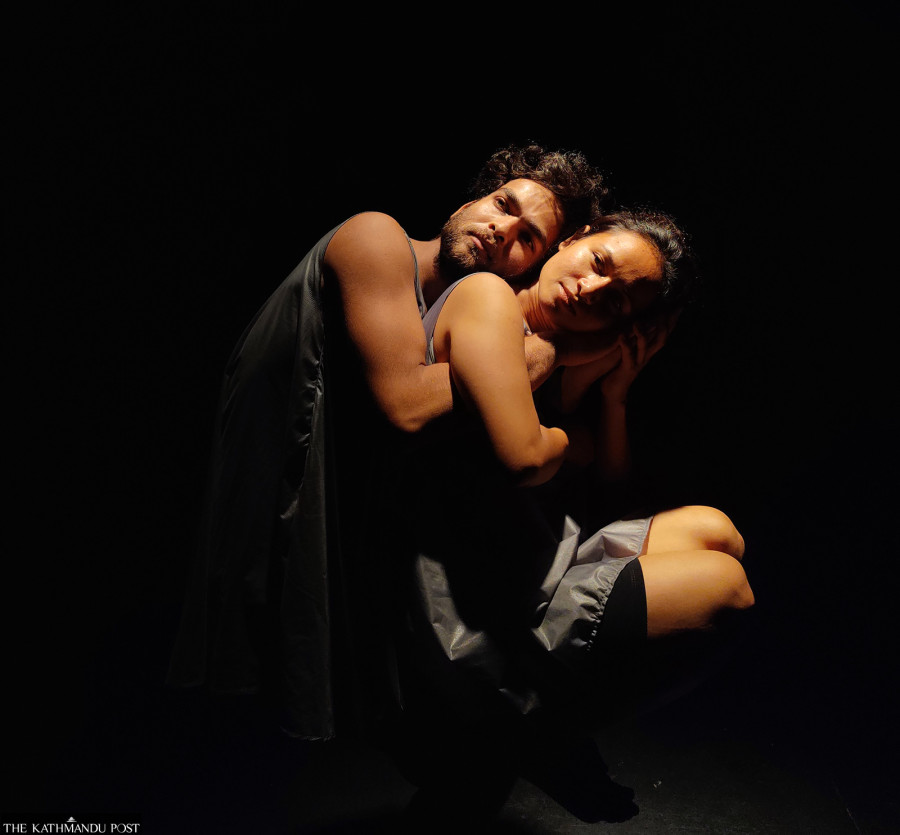Culture & Lifestyle
The power of plays to be a visceral experience
‘Aiya! Maya’ showcases Sudam Ck’s prowess as a director as every moment in the play feels like visual poetry.
Shranup Tandukar
Before the play ‘Aiya! Maya’ is played out on stage at Kausi Theatre, Teku, some theatre artists can be seen mentally and physically preparing themselves around the almost barren stage. The five artists involved in the play—Akash Nepali, Aayan Khadka, Sarita Kathayat, Shishir Shiwakoti, Pabitra Rai, and Mukti—run, dance, do cartwheels, and simply let their bodies and mind become as free and flexible as they can be.
The rehearsal and preparation of their mindset for the play sets the overall theme of the play—emotional expression through physical movements.
Directed by Sudam Ck, the play is a one-of-a-kind theatre experience where raw human emotions, not events or conflict, move the plot forward.
While recent plays in Nepali theatres have focused on telling a story and crafting powerful narratives, the power of theatre to juxtapose unrestrained physical actions with intense human emotions has somewhat taken a back seat. In contrast, ‘Aiya! Maya’ takes us through a journey where the main goal is not to understand but to feel and experience. It’s a visceral celebration of the power of theatre as a form of performing arts.
As the play gains momentum, it starts to feel like a series of diary entries brought to life on stage. There’s a scene at the beginning of the play when the artists act as if they lost an essence of themselves. They start running around frantically, searching for themselves and others, unable to talk. In another following scene, the artists emote unravelling themselves, like they are reaching into their own depths and forcing out their creativity for the world to see.
Presenting these personal hardships in an abstract format helps to universalise them. The familiar paradox of the most personal being the most universal is in motion in the play. As the audience, we see the emotions and pain of feeling lost, not fitting in, and forcing ourselves to change ourselves to fit in, reflected on stage through the artists’ actions. In one scene, Aayan Khadka sits on a small chair in the middle of the stage while the other artists stand like statues, occasionally changing their postures on the corners of the stage. Khadka starts a monologue by reciting his daily night schedule and shares that he stands in front of a mirror contemplating his physicality and mentality before going to sleep.
The play’s minimalist approach to costume design and set design puts the spotlight on the artists, their actions and distinct motifs. While most artists wear simple grey tops and shorts, Mukti wears an additional bright red scarf. Throughout the play, he acts as an observer and protagonist viewing the world around him. As the play moves along, he also takes out a bright red umbrella and eventually a bright red diary. The motif of red colour might symbolise the overall theme of love in the play.
The stage for the play is almost barren except for a few props: there are five small white stools, and the artists bring out a long and bulky rope near the end of the play. The barrenness of the stage allows the artists to freely move around and express themselves while the minimal props are used innovatively. In one scene, while the artists and the live music artists sing the cover of the song ‘Tu Hi Re’, the stools are used as steps and placed in front one after the other allowing the artists to act as if they are crossing a river.
The play’s namesake hints at the duality of love: how it can sustain us and also damage us. Narrations of diary entries, intimate conversations between lovers, and singing of love songs are used throughout the play to emphasise the power of love. Love can be a panacea to the pain and hurt in a world that often feels cruel and unforgiving.
The prowess of director Sudam Ck shines throughout the play, as every moment in the play feels like visual poetry. The artists move with water-like fluidity, the use of smoke and lighting gives an ethereal ambience on the stage, and the live music artists—Sharmila Gurung and Shivaraj Joshi—perfectly convey the emotions illustrated on stage with background music and songs. The use of music and songs to dictate actions on stage is also a provocative aspect of the play. It provides structure and rhythm to the play as we switch from scene to scene.
One of the most powerful scenes in the play is when Aayan Khadka assumes the role of an oppressor. The other artists wrap a long rope around his neck, as if they are putting a garland of flowers on him. Khadka soon realises the extent of his power and how he can make other people move, breathe, and live as he dictates. The acting skills of the other artists and the expression of Khadka as he wields his authoritative power is a scathing commentary on the political climate of our country. The leaders act like puppeteers while the common public is forced to be puppets, forgoing all their agency.
The play’s approach to theatre as an abstract art form means that it may not be everyone’s cup of tea. We, as the audience, are accustomed to being fed the story through dialogues, conflict, and action. We rarely have to think and analyse visual stories, the end of one scene perfectly linking the start to another. However, performing arts have the potential to make the audience leave their comfort zone and to make them contemplate and reflect inwards.
The play has dared to break through the comforts of a conventional approach to theatre. Without rules and structure, art can be anything. Art can be freedom, and there’s a certain beauty to art when it’s unbridled. There’s no story to be understood in the play ‘Aiya! Maya’. There’s only the opportunity for the audience to connect with the artists on stage and celebrate the emotions, good and bad, that make us human.
‘Aiya! Maya’ is being staged at Kausi Theatre, Teku, until July 16.




 13.12°C Kathmandu
13.12°C Kathmandu















